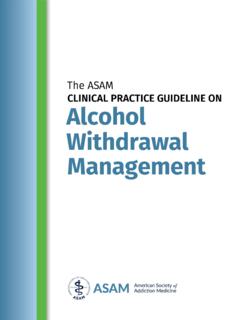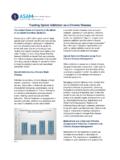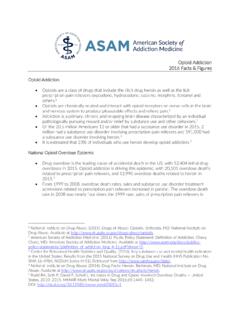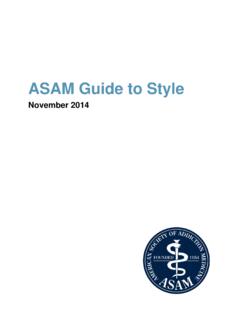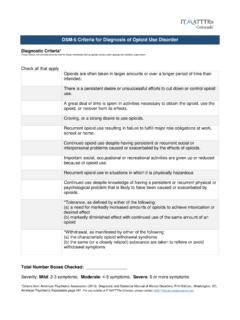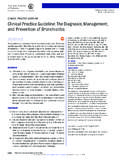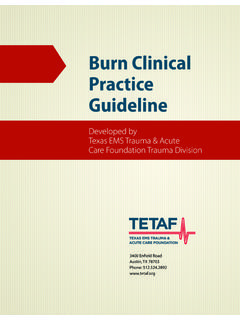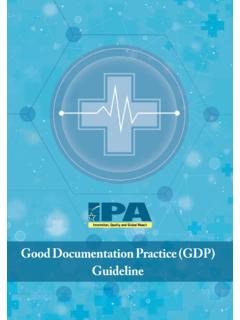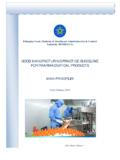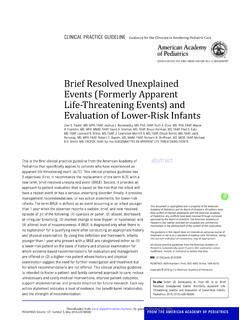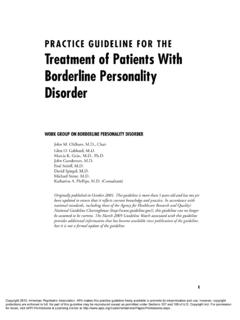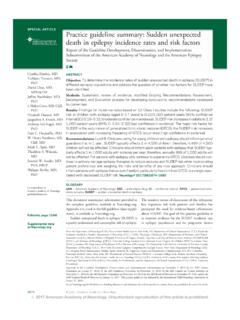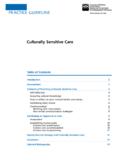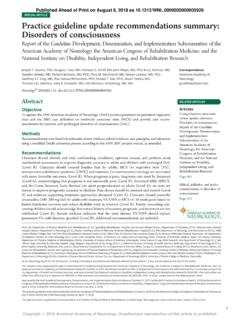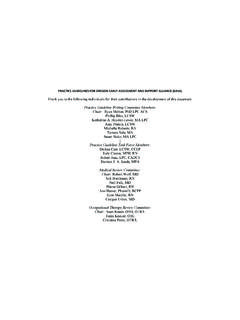Transcription of The ASAM National Practice Guideline Supplement
1 National Practice Guideline for the Use of Medications inthe Treatment of Addiction Involving Opioid UseASAM National Practice Guideline for the Use of Medi-cations in the Treatment of Addiction Involving OpioidUseGuideline Committee Members(alpha order):Sandra Comer, PhDChinazo Cunningham, MD, MSMarc J. Fishman, MD, FASAMAdam Gordon, MD, MPH, FASAMKyle Kampman, MD,ChairDaniel Langleben, MDBen Nordstrom, MD, PhDDavid Oslin, MDGeorge Woody, MDTricia Wright, MD, MSStephen Wyatt, DOASAM Quality Improvement Council(alpha order):John Femino, MD, FASAMM argaret Jarvis, MD, FASAM,ChairMargaret Kotz, DO, FASAMS andrine Pirard, MD, MPH, PhDRobert J. Roose, MD, MPHA lexis Geier-Horan,ASAM StaffBeth Haynes,ASAM StaffPenny S. Mills, MBA, ASAM,Executive Vice PresidentSpecial External Reviewer:Michael M.
2 Miller, MD, FASAM, FAPAT reatment Research Institute Technical Team Mem-bers(alpha order):Amanda Abraham, PhDKaren Dugosh, PhDDavid Festinger, PhDKyle Kampman, MD,Principal InvestigatorKeli McLoyd, JDBrittany Seymour, BAAbigail Woodworth, MSDisclosure information forGuideline Committee Members,theASAM Quality Improvement Council,andExternalReviewersis available respectively in Appendices III, IV,and of ContentsEXECUTIVE ..03 Background..03 Scope of Guideline ..04 Intended Audience..04 Qualifying Statement..04 Overview of Methodology..04 Summary of Recommendations..05 Abbreviations and Acronyms..10 National Practice Guideline Glossary..10 INTRODUCTION..14 Purpose..14 Background on Opioid Use Disorder..14 Scope of Guideline ..15 Intended Audience..15 Qualifying Statement.
3 16 METHODOLOGY..16 Overview of Approach..16 Task 1: Review of Existing guidelines ..16 Task 2: Identification of Hypothetical Statements and Appropriateness Rating..17 Task 3: Comparative Analysis, Review, and Necessity Rating..18 Task 4: Drafting the National Practice Guideline ..18 Task 5: External Review..18 Adopted by the ASAM Board of Directors June 1, 20151 NATIONALPRACTICEGUIDELINEPART 1: ASSESSMENT AND DIAGNOSIS OF OPIOID USE DISORDER..18 Comprehensive Assessment..18 Diagnosing Opioid Use Disorder..21 Summary of Recommendations..22 Areas for Further Research..23 PART 2: TREATMENT OPTIONS..23 Introduction..23 Pharmacotherapy Options..23 Efficacy Considerations..24 Summary of Recommendations..26 Areas for Further Research..27 PART 3: TREATING OPIOID WITHDRAWAL.
4 27 Background..27 Assessment of Patient for Opioid Withdrawal..27 Medications in Opioid Withdrawal..28 Summary of Recommendations..29 Areas for Further Research..29 PART 4: METHADONE..29 Background..29 Patient Selection and Treatment Goals..29 Course of Treatment..30 Switching Treatment Medications..30 Summary of Recommendations..31 Areas for Further Research..31 PART 5: BUPRENORPHINE..32 Background..32 Patient Selection and Treatment Goals..32 Course of Treatment..32 Switching Treatment Medications..34 Summary of Recommendations..35 Areas for Further Research..35 PART 6: NALTREXONE..35 Background..35 Patient Selection and Treatment Goals..36 Course of Treatment..36 Switching Treatment Medications..37 Summary of Recommendations..37 Areas for Further Research..37 PART 7: PSYCHOSOCIAL TREATMENT IN CONJUNCTION WITH MEDICATIONS FOR THETREATMENT OF OPIOID USE DISORDER.
5 38 Background..38 Efficacy of Psychosocial Treatments in Opioid Use Disorder..38 Adherence to Psychosocial Treatment within Overall Treatment..38 Summary of Recommendations..39 Areas for Further Research..39 PART 8: SPECIAL POPULATIONS: PREGNANT WOMEN..39 Background..39 Assessment of Opioid Use Disorder in Pregnant Women..40 Opioid Agonist Treatment in Pregnancy..40 Naltrexone in Pregnancy..41 Naloxone in Pregnancy..41 Methadone Induction..41 Buprenorphine Induction..41 Dosing of Opioid Agonists during Pregnancy..41 Breastfeeding..42 Summary of Recommendations..42 Areas for Further Research..43 PART 9: SPECIAL POPULATIONS: INDIVIDUALS WITH PAIN..43 Background..43 Kampman et al Adopted by the ASAM Board of Directors June 1, 20152 2015 American Society of Addiction MedicineEXECUTIVE SUMMARYP urposeThe American Society of Addiction Medicine (ASAM)developed thisNational Practice Guideline for the Use ofMedications in the Treatment of Addiction Involving OpioidUseto provide information on evidence-based treatment ofopioid use disorder.
6 (Hereafter, in this document, this NationalPractice Guidelinewill be referred to as Practice Guideline . )BackgroundOpioid use disorder is a chronic, relapsing disease,which has significant economic, personal, and public healthconsequences. Many readers of thisPractice Guidelinemayrecognize the term opioid use disorder as it is used in theDiagnostic and Statistical Manual of Mental Disorders, 5thEdition(DSM-5), developed by the American PsychiatricAssociation; others may be more familiar with the term opioid dependence, as used in previous editions of American Society of Addiction Medicine definesaddiction as a primary, chronic disease of brain reward,motivation, memory, and related circuitry, with a dysfunc-tion in these circuits being reflected in an individualpathologically pursuing reward and/or relief by substanceuse and other behaviors.
7 In this context, the preferred termby ASAM for this serious bio-psycho-social-spiritual illnesswould be addiction involving opioid use. ASAM viewsaddiction as a fundamental neurological disorder of brainreward, motivation, memory, and related circuitry, and rec-ognizes that there are unifying features in all cases of addic-tion, including substance-related addiction and nonsubstance-related addiction. It is clear that a variety of substancescommonly associated with addiction work on specific recep-tors in the nervous system and on specific neurotransmittersystems. Specific pharmacological agents used in theGeneral Considerations for All Patients with Pain..43 Pain Management in Patients Using Opioids..43 Naltrexone and Pain Management..44 Summary of Recommendations.
8 44 Areas for Further Research..44 PART 10: SPECIAL POPULATIONS: ADOLESCENTS..44 Background..44 Pharmacotherapy Options for Adolescents..45 Summary of Recommendations..45 Areas for Further Research..45 PART 11: SPECIAL POPULATIONS: INDIVIDUALS WITH CO-OCCURRING PSYCHIATRICDISORDERS..45 Background..45 Assessment of Psychiatric Co-occurrence..46Co-occurring Psychiatric Disorders and Agonist Treatment..46Co-occurring Psychiatric Disorders and Antagonist Treatment..46 Summary of Recommendations..46 PART 12: SPECIAL POPULATIONS: INDIVIDUALS IN THE CRIMINAL JUSTICE SYSTEM..47 Background..47 Effectiveness of Pharmacotherapy..47 Treatment Options..47 Summary of Recommendations..48 Areas for Further Research..48 PART 13: NALOXONE FOR THE TREATMENT OF OPIOID OVERDOSE..48 Introduction.
9 48 Patients and Significant Others/Family Members..48 Individuals Trained and Authorized to Use Naloxone..48 Safety and Efficacy of Bystander Administered Naloxone..48 Routes of Administration..49 Summary of Recommendations..49 PART 14: AREAS FOR FURTHER RESEARCH..49 References..50 Appendices..54 Appendix I: Clinical References Reviewed..54 Appendix II: Bioequivalence Information and Charts..55 Appendix III: Guideline Committee Member Relationships with Industry and Other Entities..57 Appendix IV: ASAM Quality Improvement Council (Oversight Committee) Relationships with Industry andOther Entities..59 Appendix V: External Reviewer Relationships with Industry and Other Entities..60 Adopted by the ASAM Board of Directors June 1, 2015 The ASAM National Practice Guideline 2015 American Society of Addiction Medicine3treatment of addiction exert their effects via their actions onspecific receptors.
10 Hence, the medications used in the treat-ment of addiction have specific efficacy based on their ownmolecular structure and the particular neurotransmittersaffected by that medication. Medications developed for thetreatment of addiction involving opioid use may have benefitsin the treatment of addiction involving an individual s use ofother substances. For instance, naltrexone, which is approvedby the US Food and Drug Administration (FDA) for the treat-ment of opioid dependence using DSM, 4th Edition (DSM-IV)terminology, is also US FDA-approved for the treatment ofalcohol dependence as per the DSM-IV American Society of Addiction Medicinerecognizesthat research is yet to be done to confirm the specificity of itsconceptualization of addiction as a medical and a psychiatricillness.
